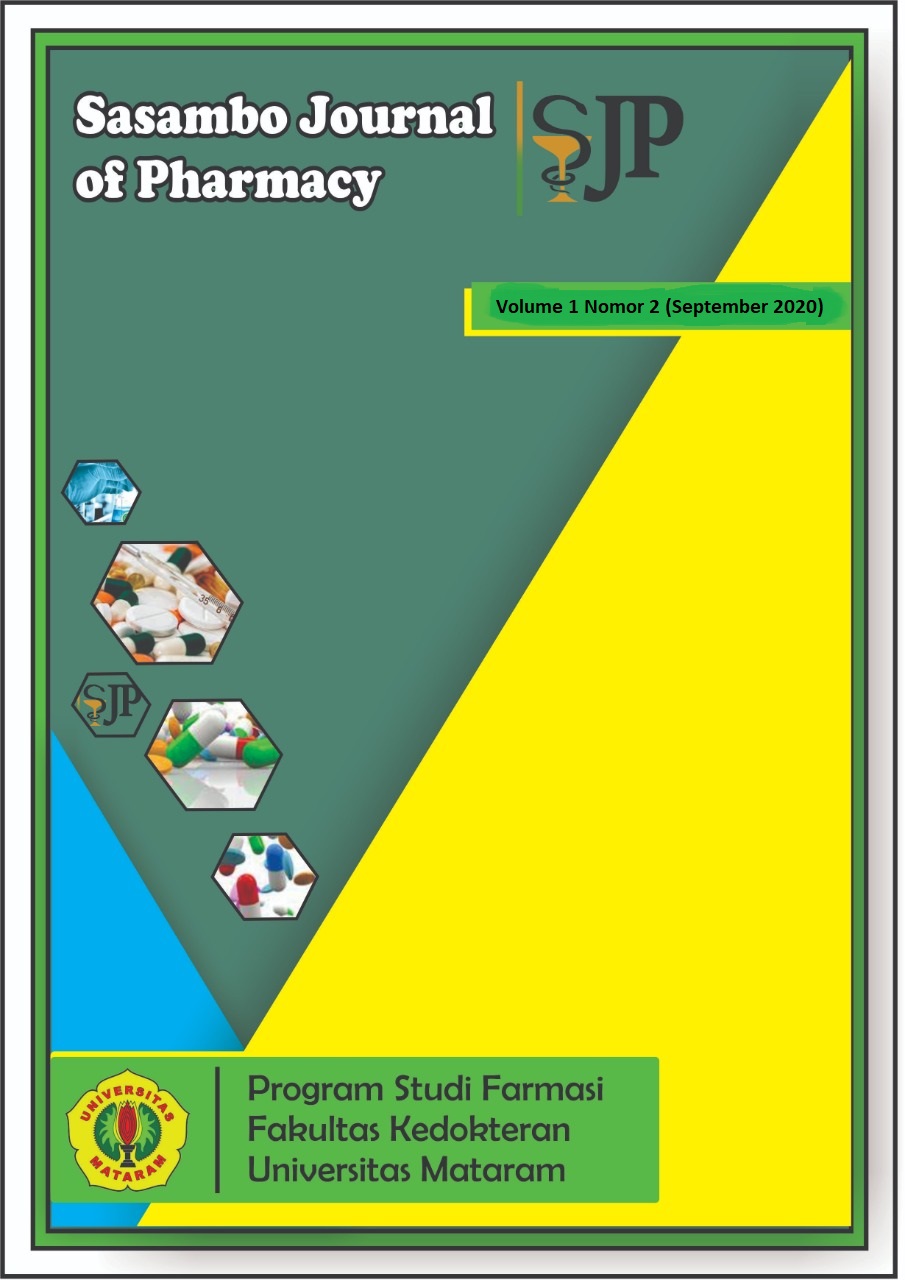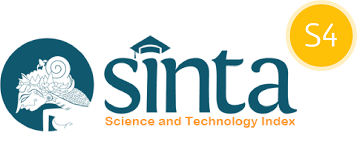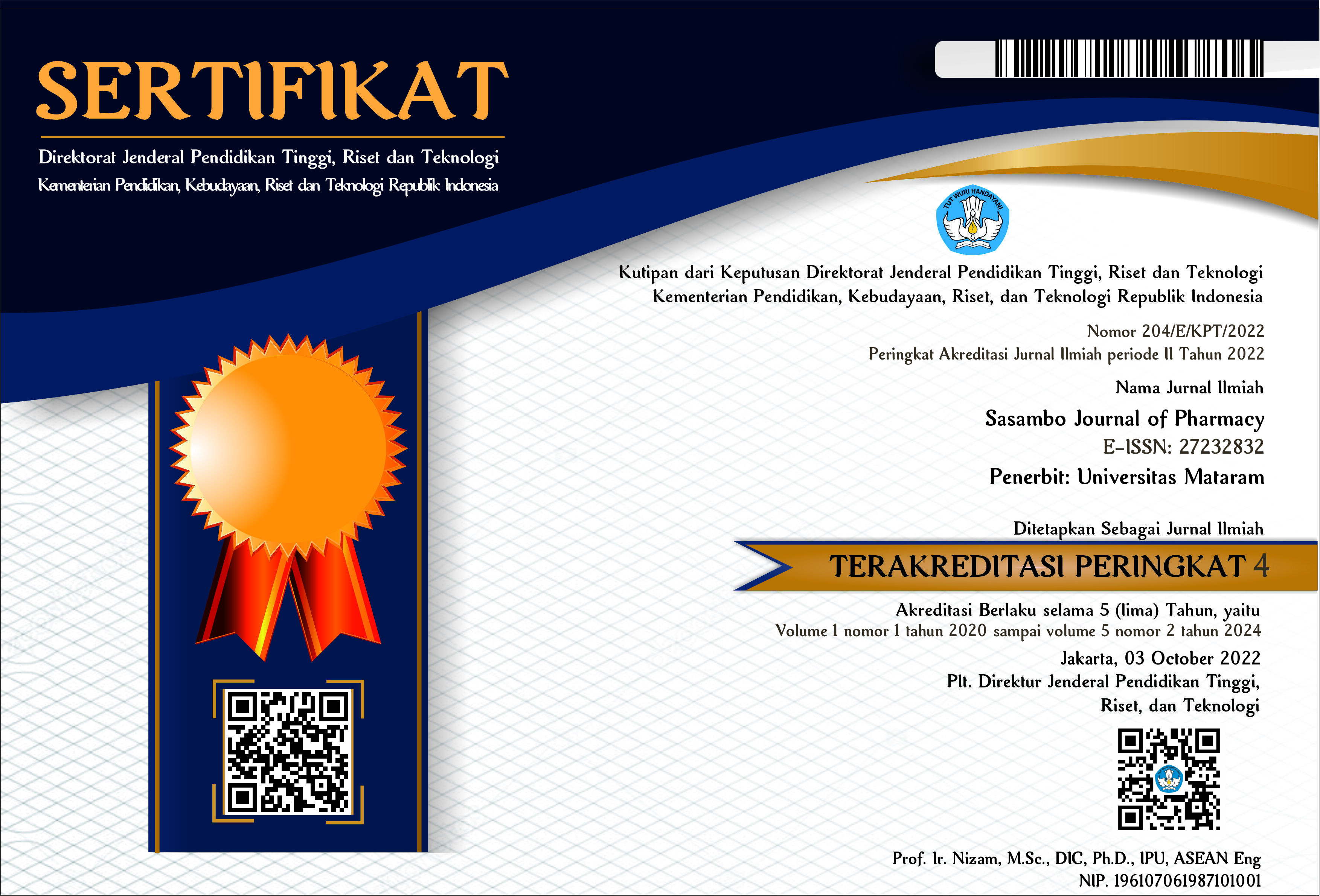Uji Aktivitas Antimikroba Ekstrak n-Butanol Madu Hutan (Apis nigrocincta) dari Kabupaten Selayar dengan Metode KLT-Bioautografi
DOI:
10.29303/sjp.v1i2.34Downloads
Abstract
Preliminary research has been conducted on the antimicrobial activity of n-Butanol extract of forest honey (Apis nigrocincta). This study aims to determine the antimicrobial activity of forest honey from Selayar Regency on the growth of test microbes, using the method of solid dilution with the test microbial Bacillus subtilis, Staphylococcus aureus, Streptococcus mutans, Pseudomonas aeruginosa, Salmonella typhi, Escherichia coli, Vibrio sp, Staphylococcus epidermidis, and Candida albicans against n-butanol extract from forest honey (Apis nigrocincta) at 1 mg/ml. The results obtained showed that n-butanol extract inhibited the growth of bacteria Bacillus subtilis, Escherichia coli, Staphylococcus aureus, Staphylococcus epidermidis, and Staphylococcus aureus. To estimate the compounds that provide antimicrobial activity, the TLC-Bioautography test is performed. Obtained the best results from the separation of compounds by TLC using Chlorophorom eluate: Acetone (3: 1). The TLC-Bioautographic test results showed that the spots with an Rf value of 0.29 gave activity to Bacillus subtilis, Escherichia coli, and Staphylococcus epidermidis, and gave positive results on the appearance of flavonoid compounds.Keywords:
Forest honey (Apis nigrocincta), antimicrobial, n-Butanol extractReferences
Dewi, i. S. (2018). Analisis kelayakan finansial budidaya lebah madu di desa kuapan kecamatan tambang kabupaten kampar (kasus usaha madu “mekar sariâ€). Jurnal agribisnis. Https://doi.org/10.31849/agr.v20i1.1495
Hadisoesilo, s. (2001). The Diversity of Indigenous Honey Bee Species of Indonesia. Biodiversitas, Journal of Biological Diversity. https://doi.org/10.13057/biodiv/d020107.
Murtidjo, B., 1991., Memelihara Lebah Madu., Kanisus,Yogyakarta.
Rahalison, L., Hostcman. K, 1991., A Bioautographis Agar Overlay Method for The Detection of Antifungal Compounds for Higher Plants Phykochemical Analysis, Vol. 2 University de Laausanne Swtecrland.
Rostita., 2007., Madu Sehat Cantik dan Penuh Vitalis., PT Mizan Pustaka, Bandung.
Sutrisno.R., 1993., Pereaksi KLT., Fakultas Farmasi Universitas Pancasila, Jakarta.
Tobo, F., Mufidah, Taebe, B dan Mahmud, I., 2001., Buku Pegangan Laboratorium Fitokimia I (Ekstraksi Komponen Kimia Bahan Alam). Laboratorium Fitokimia Jurusan Farmasi, FMIPA., Universitas Hasanuddin, Makassar.
Wiryowidagdo., S., 1990., Penelitian dan Pengembangan Obat Tradisional Dalam Pengobatan Modern., Penelitian Regional Peningkatan Peran Serta Masyarakat Bagi Petugas Dati II Dalam Pembinaan Upaya Kesehatan Tradisional. Ujung Pandang
Wineri, E., Rasyid, R., & Alioes, Y. (2014). Perbandingan Daya Hambat Madu Alami dengan Madu Kemasan secara In Vitro terhadap Streptococcus beta hemoliticus Group A sebagai Penyebab Faringitis. Jurnal Kesehatan Andalas. https://doi.org/10.25077/jka.v3i3.140
License
Authors who publish with Sasambo Journal of Pharmacy (SJP), agree to the following terms:
- Authors retain copyright and grant the journal right of first publication with the work simultaneously licensed under a Lisensi Creative Commons Atribusi 4.0 Internasional. This license allows authors to use all articles, data sets, graphics and appendices in data mining applications, search engines, web sites, blogs, and other platforms by providing an appropriate reference. The journal allows the author(s) to hold the copyright without restrictions and will retain publishing rights without restrictions.
- Authors are able to enter into separate, additional contractual arrangements for the non-exclusive distribution of the journal's published version of the work (e.g., post it to an institutional repository or publish it in a book), with an acknowledgment of its initial publication in Sasambo Journal of Pharmacy
- Authors are permitted and encouraged to post their work online (e.g., in institutional repositories or on their website) prior to and during the submission process, as it can lead to productive exchanges, as well as earlier and greater citation of published work (See The Effect of Open Access).







